‘Which Venice train station is best to get off at?’ is a question that plays on the mind of many visitors to Italy’s city of water.
After all, Venice – or Venezia as it is known in Italian – has two main railway stations: Venezia Santa Lucia and Venezia Mestre.
You may be arriving by train in Venice from another large Italian city like Milan, Verona, Bologna, Naples or even the capital Rome. You may be travelling to Venice by train from a different country. The city of water has great railway connections to Vienna in Austria, Munich in Germany, and Paris in France.
Tired after the long journey, it’s only natural to grab your bags and get ready to get off the train as soon as the sign of the Venezia Mestre railway station comes into view. Should you do it though or should you remain in your seat and wait until the train reaches its final destination – the Venezia Santa Lucia train station?!

This blog post will give you the answer that you need.
For this, we will start with a short introduction to Venice’s unique urban plan. This will make it clear why Venice needs two main train stations and which one would be the best for you to alight at. To conclude, I will give you lots of tips on how to book train tickets in Italy and how to reach Venice’s major landmarks once you’ve arrived in the city of water by train.
I hope that all this information will help you plan your train trip to Venice in the easiest way. In addition, and especially if this will be your first visit to Italy’s city of water, have a look at these blog posts:
- 45 Essential Tips for Venice
- 20 Venice Landmarks You Simply Have to See
- 101 Hidden Gems in Venice
- How to Navigate Venice Like a Local
Otherwise, let’s tuck into the topic at hand!
Which Venice Train Station is Best – Venezia Santa Lucia or Venezia Mestre (With Map and Practical Tips)
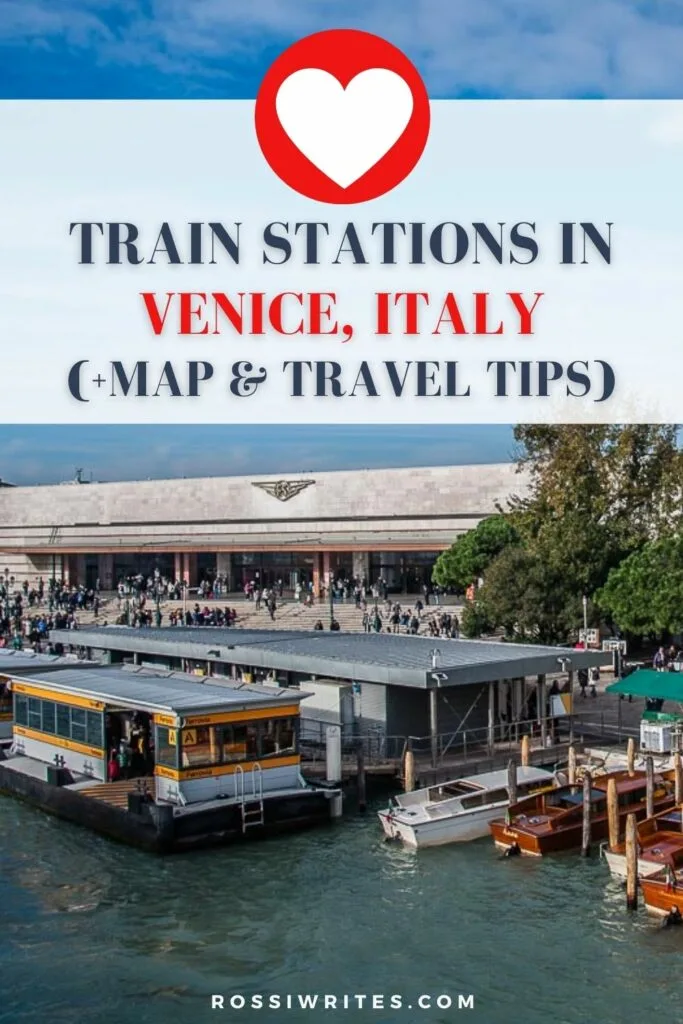
Where is Venice and What’s Its Layout?
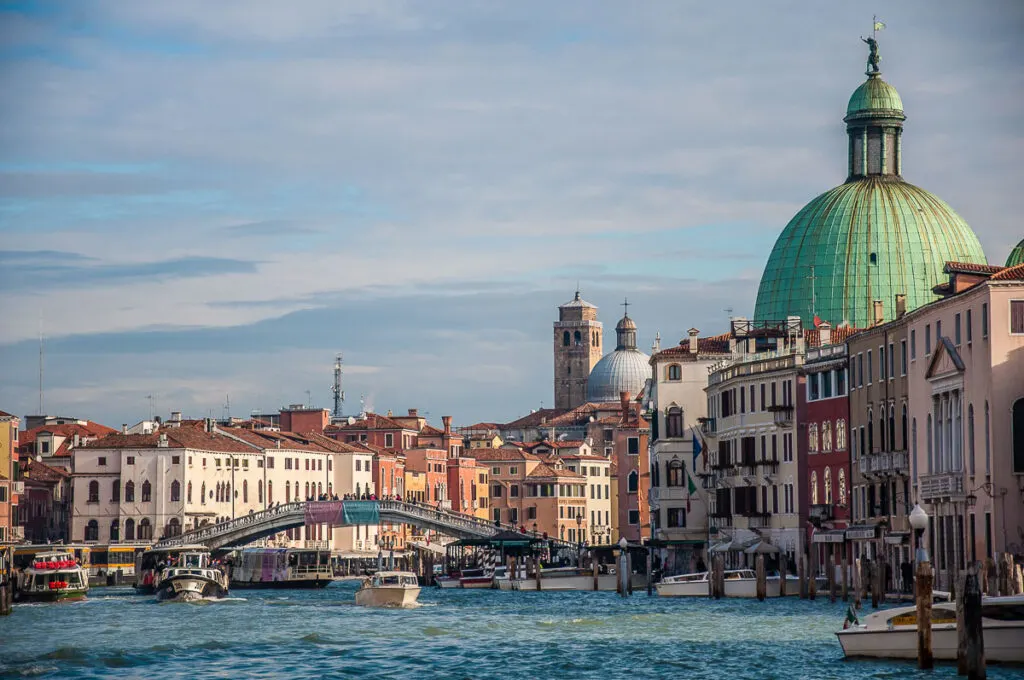
Known as Venezia in Italian, Venice is a worldwide famous city in Italy. It has a unique urban plan, centuries-old history, and a rich catalogue of art. It attracts millions of visitors each year.
The City of Venice (or Comune di Venezia in Italian) is also the capital of the Italian region of Veneto. Geographically, Venice stands in northeastern Italy. Administratively, it is composed of several different parts. These are:
- The historic centre of Venice – built on a cluster of 118 small islands in the Venetian Lagoon and surrounded by water on all sides, this is Venezia proper in terms of history, architecture, and art. For over a thousand years, it was the capital of the historic Republic of Venice. Nowadays, it is one of the biggest tourist destinations in the world. Dozens of major landmarks, must-see museums, and important churches are concentrated here. About 53,000 people live in the historic centre of Venice.
- The mainland area of Venice – a collection of mainland towns and boroughs. In general, these are heavily industrialised and don’t offer the attractions of Venice. The most well-known ones are Mestre and Marghera. About 180,000 to 200,000 (depending on the source) people live in the mainland area of Venice. Just under 90,000 of them are in Mestre. Mestre has its own historic centre but this is not on par with Venice. It’s a place that offers convenient shopping, cheaper accommodation, and it has the rather striking M9 Museum of the 20th Century.
- Other islands in the Venetian Lagoon – several other islands dotted around the Venetian Lagoon are part of the Comune di Venezia. Among them are Lido di Venezia, Murano, and Burano.
A long bridge connects the Venetian mainland to the historic centre of Venice. The bridge has two parts:
- Venice Railroad Bridge – completed in 1846, this is the railway track bridge that allows trains to reach the historic centre of Venice across the water. The railway tracks end at Venezia Santa Lucia which is an end of the line train station.
- Liberty Bridge (in Italian, Ponte della Liberta’) – completed in 1933, this is the road bridge that allows cars, buses, and other vehicles to reach Piazzale Roma and the island of Tronchetto in Venice. Tronchetto serves as a large car park. There are parking facilities at Piazzale Roma, too.
Where Are Venice’s Two Main Train Stations Located?
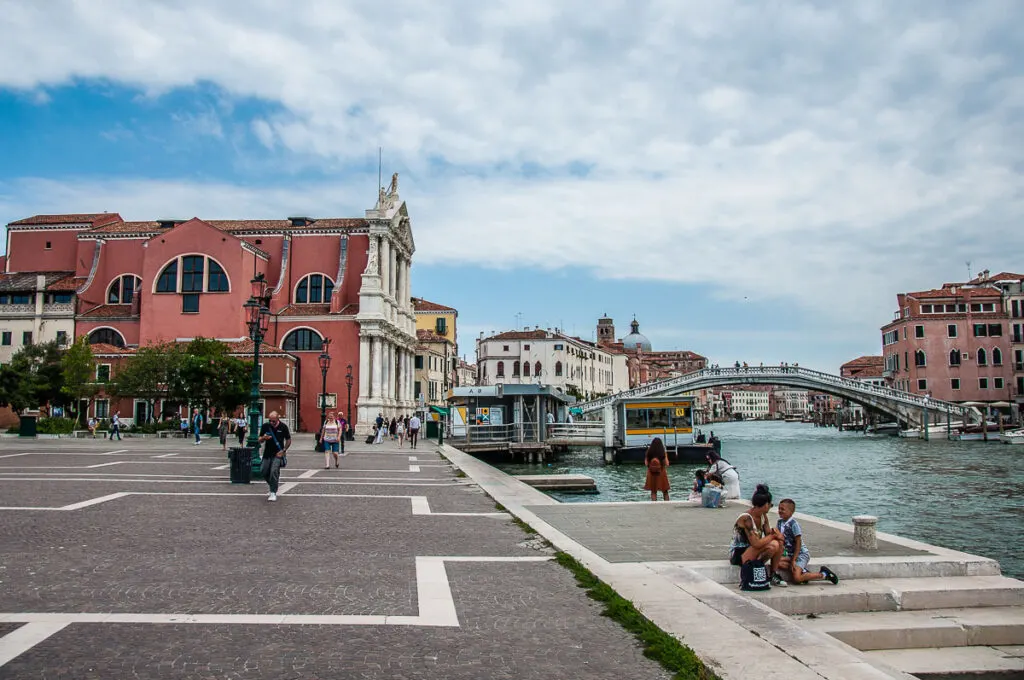
Venice has two main train stations. They are:
- Venezia Mestre train station – this is the train station that serves the Venetian mainland. It’s in the borough of Mestre on the mainland.
- Venezia Santa Lucia train station – this is the train station that serves the historic centre of Venice in the Venetian Lagoon. It’s in the sestiere of Cannaregio near the western end of the Grand Canal.
Both the Venezia Mestre train station and the Venezia Santa Lucia train station are on the same railway line. This means that if you want to visit Venice, your train will stop first at Venezia Mestre and it will then continue to Venezia Santa Lucia.
Unless you have a specific interest in Mestre or have booked accommodation there, don’t get off at the Venezia Mestre train station. Stay on the train, wait for it to cross the long Ponte della Liberta’ and then stop at Venezia Santa Lucia. This is an end of the line railway hub, so once the trains arrive here, they don’t continue onwards.
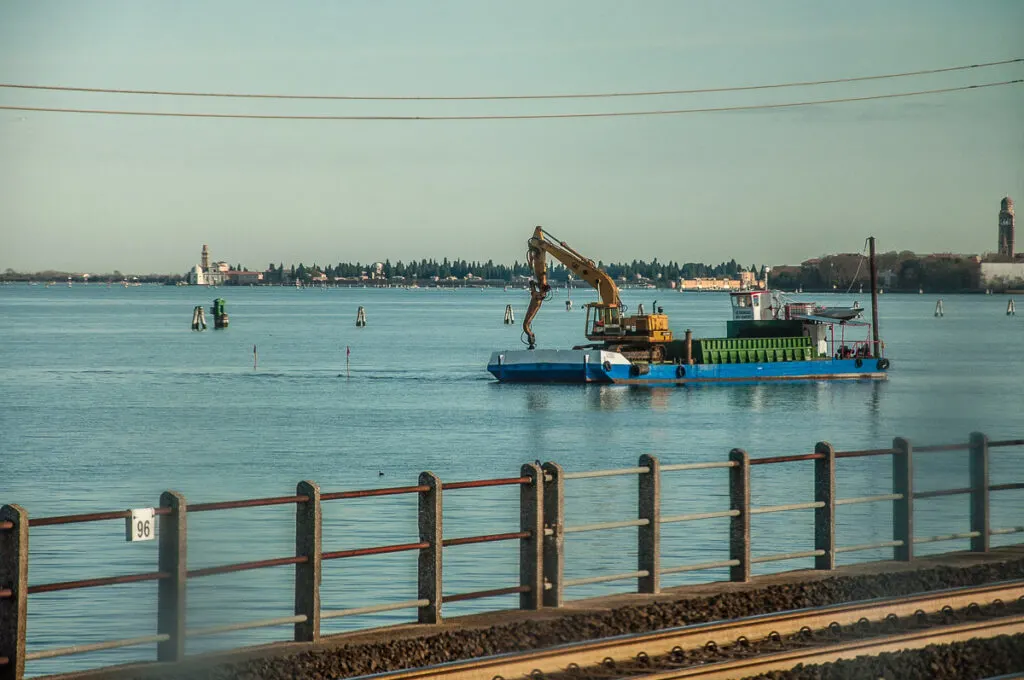
To put it simply, don’t get off the train until you have seen water on both sides of the bridge and then when the train stops, everyone around you grabs their bags and prepares to get off. Then you can be sure that you have reached Venice. The photo above shows you the view from the train as it travels on the railroad bridge across the Venetian Lagoon.
Bear in mind that if you are travelling on a slow regional train (treno regionale in Italian), it may also stop at the Venezia Porto Marghera train station. This is a small train station between Venezia Mestre and Venezia Santa Lucia. The fast regional trains and the high-speed trains don’t stop at it. Again, don’t get off here. Wait until the train has reached Venezia Santa Lucia.
Here is a map showing the locations of Venice’s two main train stations: Venezia Mestre and Venezia Santa Lucia. You can zoom in and out, open the map in a new tab, and also use the map to calculate travelling times depending on your point of departure.
N.B.: Many guidebooks and travel blogs suggest that you stay in Mestre as hotels there tend to be cheaper. Yet, if you want to explore the beauty and heritage of Venice and to truly feel the authentic atmosphere of the city of water, then I would strongly suggest that you book your accommodation in the historic centre of Venice.
This way you will also avoid the daily commute from Mestre to Venice and then the much longer walk or boat ride to the different landmarks. You will also have Venice all for yourself in the early mornings and the late evenings. If this is your first or, you suspect, only visit to Venice, then it’s advisable to have the full Venetian experience by actually staying in the historic centre.
Accommodation in Venice: Do you need help booking accommodation in Venice? From personal experience, I can recommend the following hotels in the historic centre: Scalon del Doge, Hotel Torino, and Hotel Moresco.
When I travel, I book all my accommodation through Booking.com. I choose based on location, distance from the sights I want to visit, my budget, and the reviews left by real people. Click to see all available options for places to stay in Venice, Italy.
Practical Tips for Train Travel in Italy
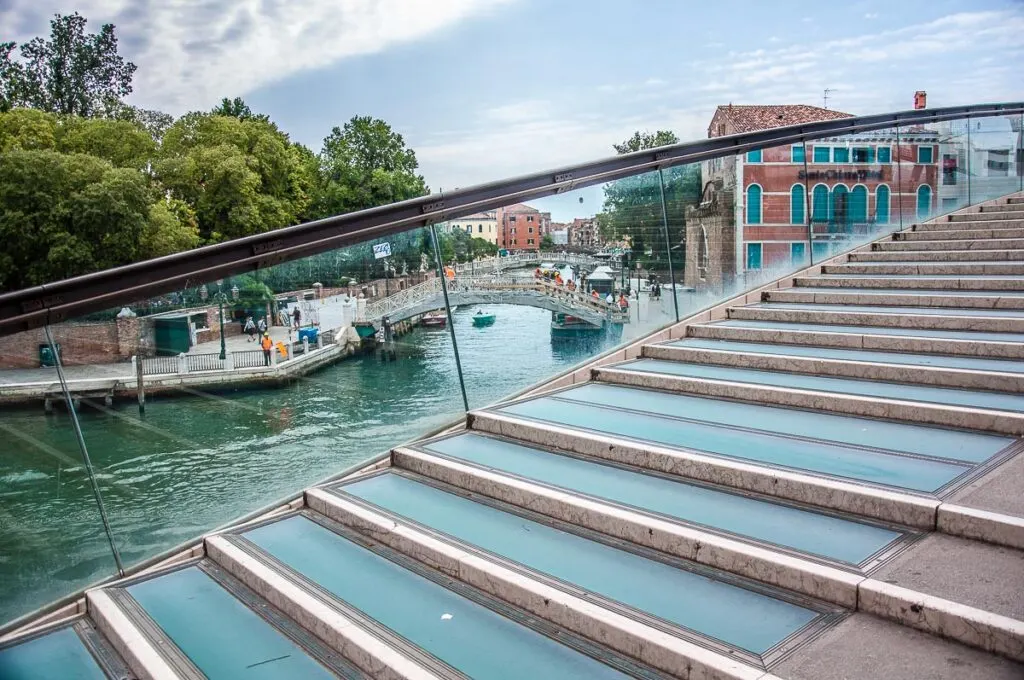
Here are a few practical tips to make your trip to Venice by train an easy and enjoyable experience. They are all based on my many visits by train to Venice during the six years that I spent living in the nearby city of Vicenza in Italy.
I find train travel in Northern Italy, in general, very well organised. Simply put there are three types of trains here:
- high-speed trains (Frecciarossa, Frecciabianca, ItaloTreno) – incredibly fast, they connect Venice to many large Italian cities like Milan, Bologna, Florence, and Naples, as well as to the Italian capital Rome. With short travelling times, they are a great way to travel in style.
- fast regional trains (treno regionale veloce) – these are perfect if you are travelling to Venice from another city in the region of Veneto. For example, Padua, Vicenza or even Verona. Fast and inexpensive, they run often throughout the day and provide cheap and dependanble transport.
- regional trains (treno regionale) – these are slow regional trains that stop at every single station along the way no matter how small. This type of trains take a considerable amount of time to cover even the shortest distance. Use them only if you are travelling to Venice from either Padua, Treviso, Bassano del Grappa, Mestre or another such small nearby town or city. The tickets for the regional trains cost the same as for the fast regional trains.
Tickets for the high-speed trains increase in price the closer to the date of departure it gets. It pays to buy them well in advance either online or at the train station.
The price of the tickets for the fast regional and the regional trains remains the same no matter when you buy them. You can quickly get a ticket from the automated machines at the train station literally minutes before you board the train. Just don’t forget to validate the ticket by placing it into one of the special machines attached to walls and pillars at the Italian train stations.
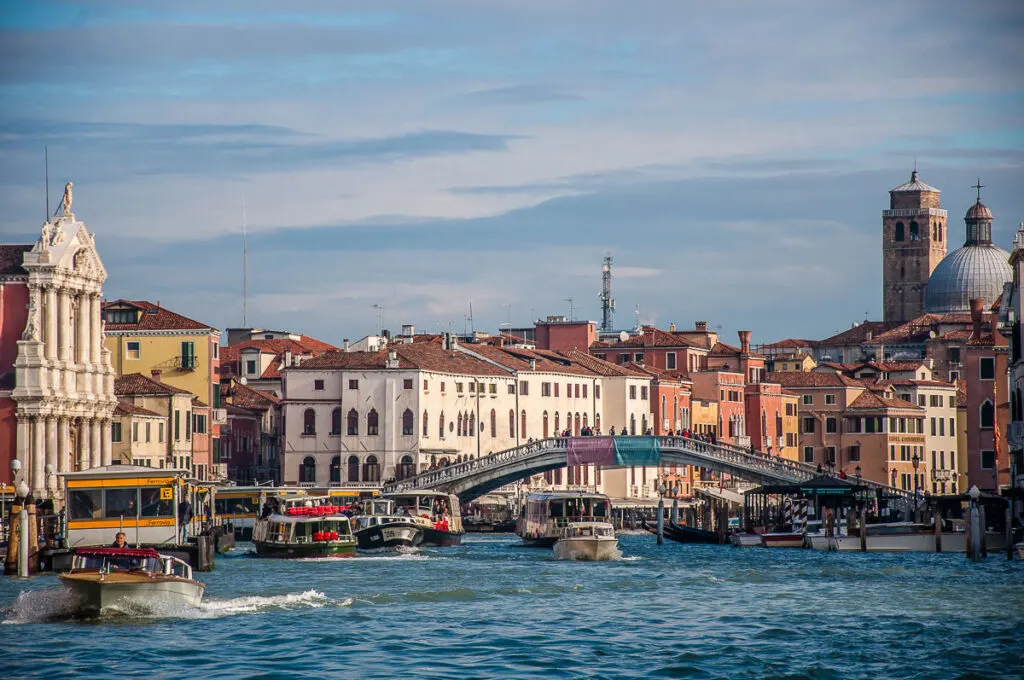
You can check train times and ticket prices in advance on Omio. This is my favourite search engine to research and book tickets for trains in Italy. Omio pulls up a page with results from different railway companies. This way, you can see immediately who offers the cheapest prices and the shortest times and you can book your tickets on the spot. It really makes travel planning so much quicker and easier.
In my experience, trains in Northern Italy run, in general, on time. Trains tend to arrive a couple of minutes before the announced departure time and just stay at the platform with their doors open thus giving you a chance to board without rushing and pushing.
The fast regional trains between Vicenza, Padua, and Venice tend to be very busy in the morning. This is when students commute for their classes at the University of Padua and the University of Venice. Many people commute for their jobs, too. On very busy mornings it can sometimes be difficult to find a place to sit for a stop or two.
The rest of the time, the carriages are often half-empty.
If you forget to validate your ticket for the regional or the fast regional train, try finding the ticket inspector on board of the train and politely explain your situation. Based on personal observations, I have found ticket inspectors on trains in Italy very strict and exacting. They often speak other languages and can apply very large fines. Speaking politely and with respect is always the best way to communicate, especially if for whatever reason you purchased the wrong ticket or forgot to validate it. Avoid making a scene or pretending that you don’t understand the ticket inspector.
Practical Tips for Navigating the Venezia Santa Lucia Train Station
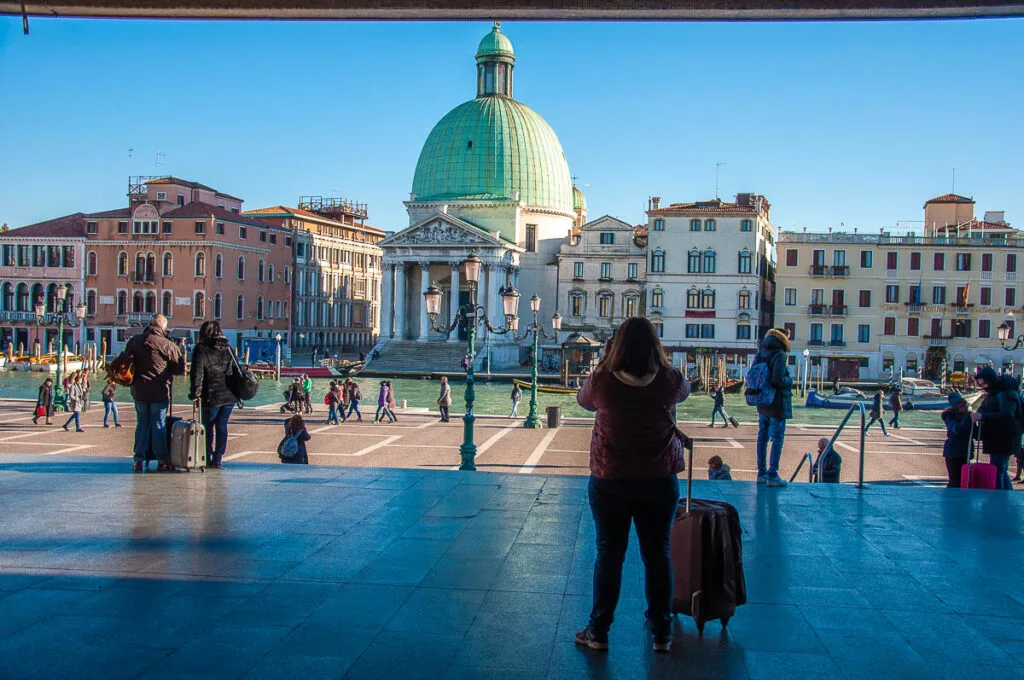
Venezia Santa Lucia is an end of the line train station that serves the historic centre of Venice. It stands at the end of a long railroad bridge that connects the city of water to the mainland.
The train station is in the Venetian sestiere of Cannaregio and on the western end of the Grand Canal. In fact, when you walk out of the station, the first thing that you see is a captivating view of Venice’s most important waterway with the Church of San Simeone Piccolo on its opposite bank. When you see it, you certainly know that you’ve arrived in Venice!
By the way, all the photos in this blog post were taken by me and show you both the Venezia Santa Lucia train station and its surroundings. This way you can get a good visual idea of what to expect when you arrive in Venice by train.
Venezia Santa Lucia takes its name from the Church of Santa Lucia that used to stand at its place. The church was demolished in the 19th century to make space for a train station.

The photo above shows a small display inside Venice’s train station. It’s dedicated to Santa Lucia who is known as St. Lucy in English (you can read more about her here). It also includes a panel with information about the Saint’s former church.
The display was arranged for the 13th of December – the Day of St. Lucy. In some corners of Italy, it is believed that she brings presents to the well-behaved kids on the eve of her day. The body of the saint nowadays is preserved in the Venetian Church of San Geremia which is a short walk away from the Venezia Santa Lucia.
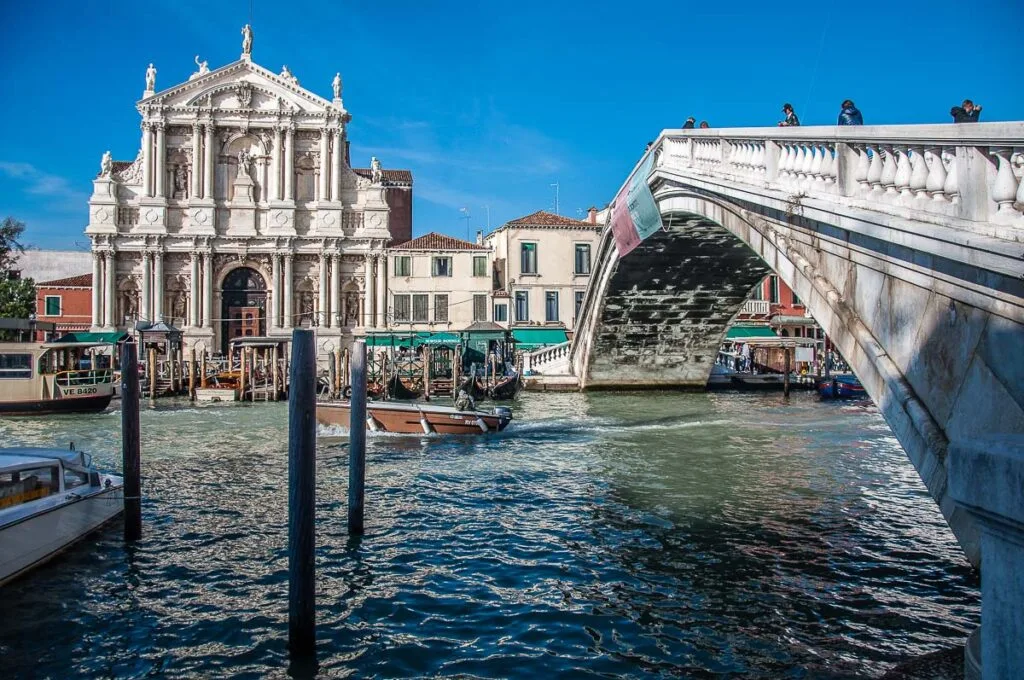
The building of Venice’s train station as we see it today was completed in 1952. It is one of the few modernist buildings in the city of water. It has a long body that is low and wide. So, it doesn’t dominate the landscape. In fact, the Church of Santa Maria di Nazareth and the Scalzi Bridge next door to the train station, as well as the Church of San Simeon Piccolo just across the Grand Canal are much more imposing and immediately grab the eye as you take your first steps in Venice.
The Constitution Bridge (also known as Calatrava Bridge after his Spanish architect) stands on the other side of Venezia Santa Lucia. The bridge leads to Piazzale Roma. Diagonally across the Grand Canal from the train station, there is a public garden with a small playground – Giardino Papadopoli.
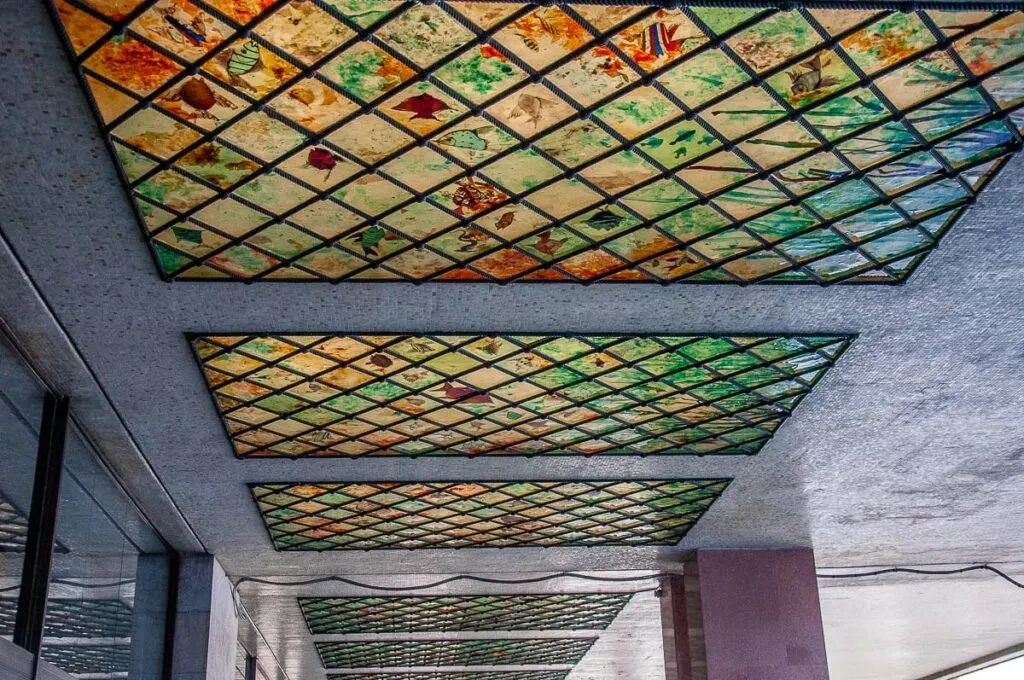
Several steps lead up to the main entrance of the Venezia Santa Lucia train station. The overhang above the top of the steps is decorated with panels of Murano glass celebrating the rich flora and fauna of the Venetian Lagoon. You have to look up to see them. The above photo shows you what to expect.
The train station’s side entrances offer step-free access. Porters congregate in front of the station offering their services to travellers arriving with heavy luggage.
Venezia Santa Lucia is one of the largest and busiest train stations in Italy. It has many shops, several eateries, over 20 platforms, a tourist information point, a left luggage service, and paid-for toilets. It deals with 30 million passengers a year. On average, it serves 450 high-speed and regional trains a day. They connect Venice to many important Italian cities like Verona, Milan, Bologna, Turin, Florence, and Naples, to the Italian capital Rome as well as to countless smaller Italian towns.
In addition, Venice also enjoys excellent railway connections to several important European cities like Vienna, Paris, Munich, and Geneva. The historic Simplon Orient Express travels to Venezia Santa Lucia, too.
How to Get from Venezia Santa Lucia to Venice’s Major Landmarks?
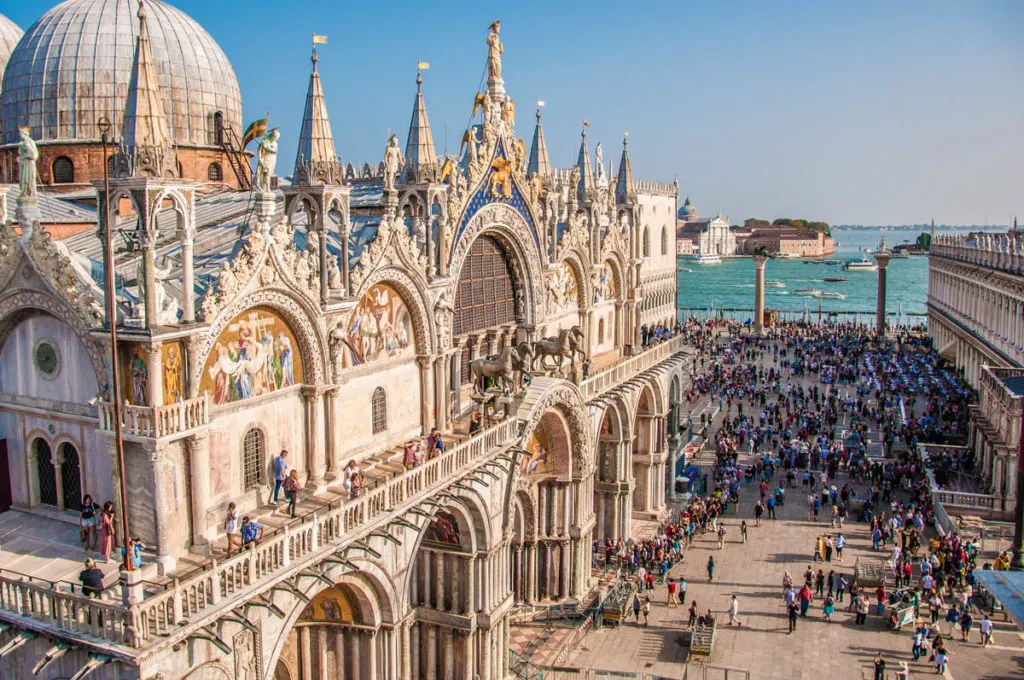
You can easily get from the Venezia Santa Lucia train station to Venice’s major landmarks either by boat or on foot.
This blog post gives you a detailed list of 20 of Venice’s must-see sights, museums, and churches. It also has a map with their exact locations. Have a look at it to make a sightseeing plan and use the map to calculate the specific distances to those points of interest in Venice that you want to see:
Now, this is how to start your explorations of Venice from Venezia Santa Lucia:
- By boat – Venice’s water buses – known as vaporetto (pl. vaporetti) – stop right in front of the train station. You can get a ticket from the ticket kiosks next to the vaporetto stops or buy it online in advance. If this is your first visit to Venice, a trip by boat down the Grand Canal is a beautiful experience. Alternatively, you can hire a private water taxi – known as motoscafo.
- On foot – you can walk from Venezia Santa Lucia to anywhere in Venice. A long pedestrian street known as Strada Nova leads from the train station all the way to Rialto Bridge. It will take you around 20-25 minutes fast walk. Once there, you can continue to Piazza San Marco and reach Venice’s most iconic square in about 10 minutes or so. Alternatively, you can cross the Grand Canal via the Scalzi Bridge just next to the train station and then walk to such important sights as the Scuola Grande di San Rocco, the Basilica dei Frari, Ca’ Rezzonico, and the Gallerie dell’Accademia in about 10 to 25 minutes depending on your chosen destination.
This one day in Venice itinerary will give you a great idea of the ground you can cover here from morning till dusk starting from Venezia Santa Lucia:
To learn how to orient yourself like a local in Venice, then make sure that you have a look at this detailed blog post. It’s packed with useful information and tips:
If you would rather explore Venice as part of a guided tour or with a private tour guide who can meet you at Venezia Santa Lucia, then, have a look at this blog post:
In Conclusion
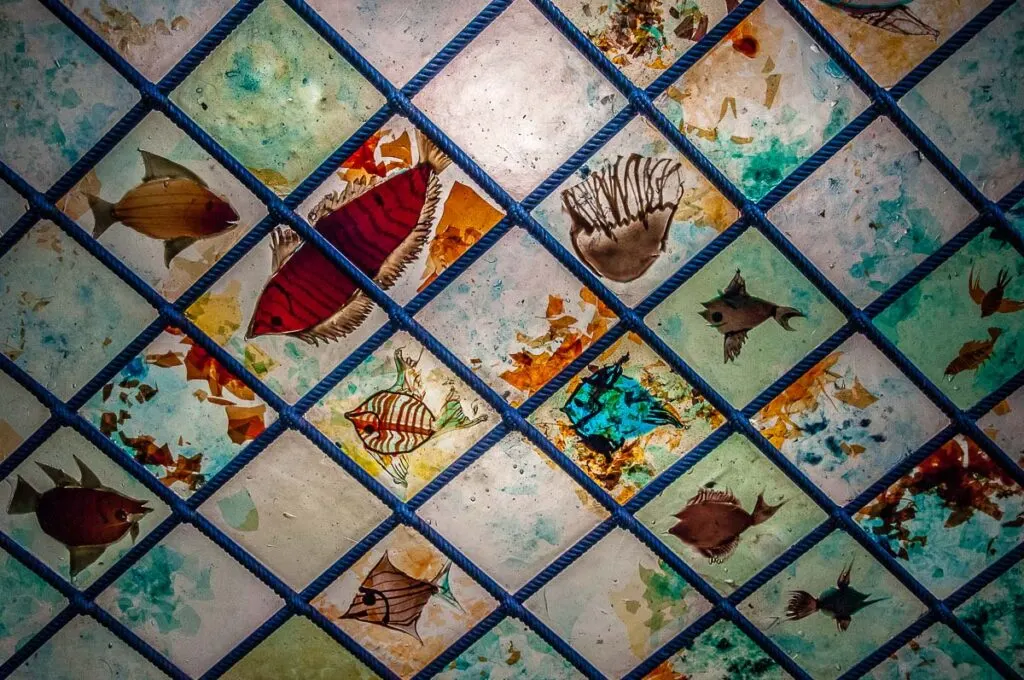
Knowing which Venice train station to get off at can mean the difference between a great start to your holiday in Venice and time wasted asking for directions and worrying that you are getting behind on your travel plans.
Venice is a worldwide famous destination that attracts millions of people every year. The city of water has a unique layout, it spreads across many islands all the way to the Italian mainland, and is served by two main train stations. Their names are: Venezia Mestre and Venezia Santa Lucia.
Which one is the best station to travel to in order to see the beauty of Venice and explore its history, architecture, and art?
This blog answers this question and provides you with lots of useful practical tips to make your exploration of Italy’s city of water as smooth and enjoyable as possible.
Have a wonderful time in Venice, Italy!
Now, get ready quick for your visit to Venice, Italy!
- Consult these guidebooks.
- Buy plane tickets to Italy.
- Book train tickets, bus tickets or rent a car.
- Research accommodation.
- Select local tours and activities.
More Helpful Venice Info for You
Venice: Essential Tips, Major Landmarks, Hidden Gems, How to Navigate Venice, Venice in a Day for Art Lovers, Nearest Airports, Best Tours, Boats in Venice, Haunted Venice, Day Trips from Venice, Arco del Paradiso
Venice Videos: Grand Canal, St. Mark’s Square at Carnival, St. Mark’s Square, View from Rialto Bridge, View from Accademia Bridge, Venetian gondolas, Historical Regatta, Squero di San Trovaso, Palazzo Contarini del Bovolo, Fondazione Querini Stampalia, Palazzo Grimani, Rialto Fish Market, Ca’ Macana, Festa della Madonna della Salute
More Helpful Italy Info for You
Italian Food: Budget Italian Food, Italian Markets, Rules of Italian Breakfast, Italian Breakfast Foods and Drinks, Italian Food Gifts
Italian Coffee: Rules of Italian Coffee Culture, Italian Coffee Drinks, History of Italian Coffee Culture
Christmas in Italy: Facts, Nativity Scenes, Things to Do, Christmas Guide
Northern Italy: Best Cities to Visit, Major Airports
Lake Garda: Best Towns, Nearest Airports, Travel Options, Lake Garda with Kids, Malcesine, Riva del Garda, Torri del Benaco
Lake Como: Things to See, Nesso
Veneto: Best Cities to Visit, Prettiest Small Towns, Beautiful Villages, Top 15 Places, 30 Adventures, Most Colourful Places, Beautiful Piazzas, Must-See Lakes
Friuli Venezia Giulia: Venzone, Most Beautiful Villages
Emilia Romagna: Bologna, Ravenna, Comacchio, Most Beautiful Villages
Marche: Reasons to Visit, Gradara, Frasassi Caves, Temple of Valadier
Verona: Things to Do in One Day, Day Trips from Verona
Padua: Things to Do in One Day, Facts About Padua, Reasons to Visit, Day Trips from Padua
Vicenza: Things to Do, Must-See Museums, Vicenza in Photos, Day Trips from Vicenza
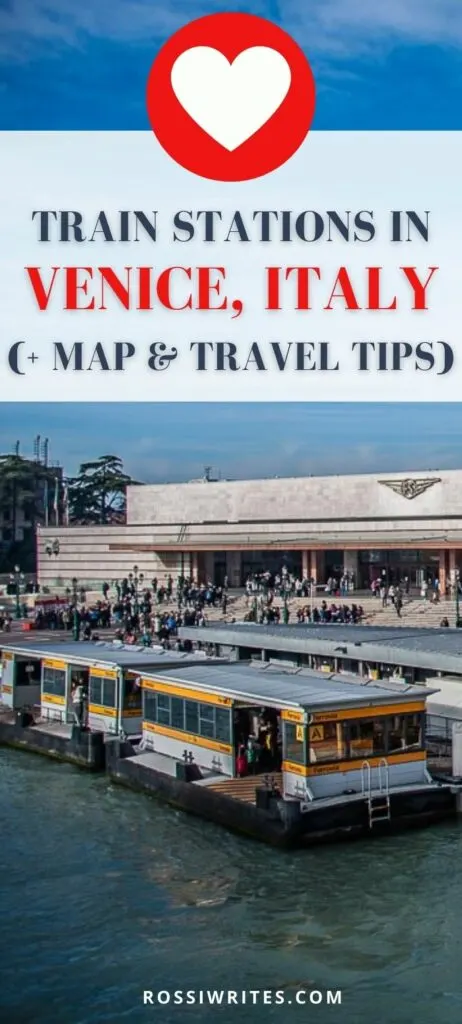
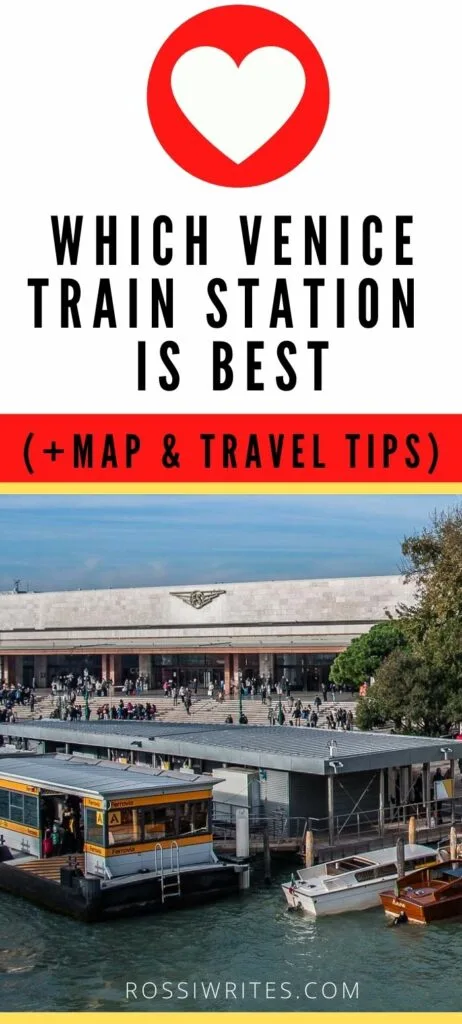

Kari MacKinnon
Friday 12th of January 2024
I am so glad I found this blog! You saved me so much time in explaining the difference between the stations. I was about about to make a serious error in assuming the Mestre station was the one we needed.
admin
Saturday 13th of January 2024
Thank you for your kind words! I am glad my blog post was of help Have a great time in Venice!
Rossi :)
Christine Witton
Tuesday 31st of May 2022
Thanks again Rossi We have stayed in Mestre in 1973 and later trips have been in Venice itself. With the new Venice tax, it will be interesting to see where people stay and how that affects the influx of tourists.
admin
Wednesday 1st of June 2022
Yes, that's a very good point. I am also curious to see how this new tax is going to work. I would still prefer to stay in Venice for the atmosphere and the history, though. Best wishes,
Rossi :)